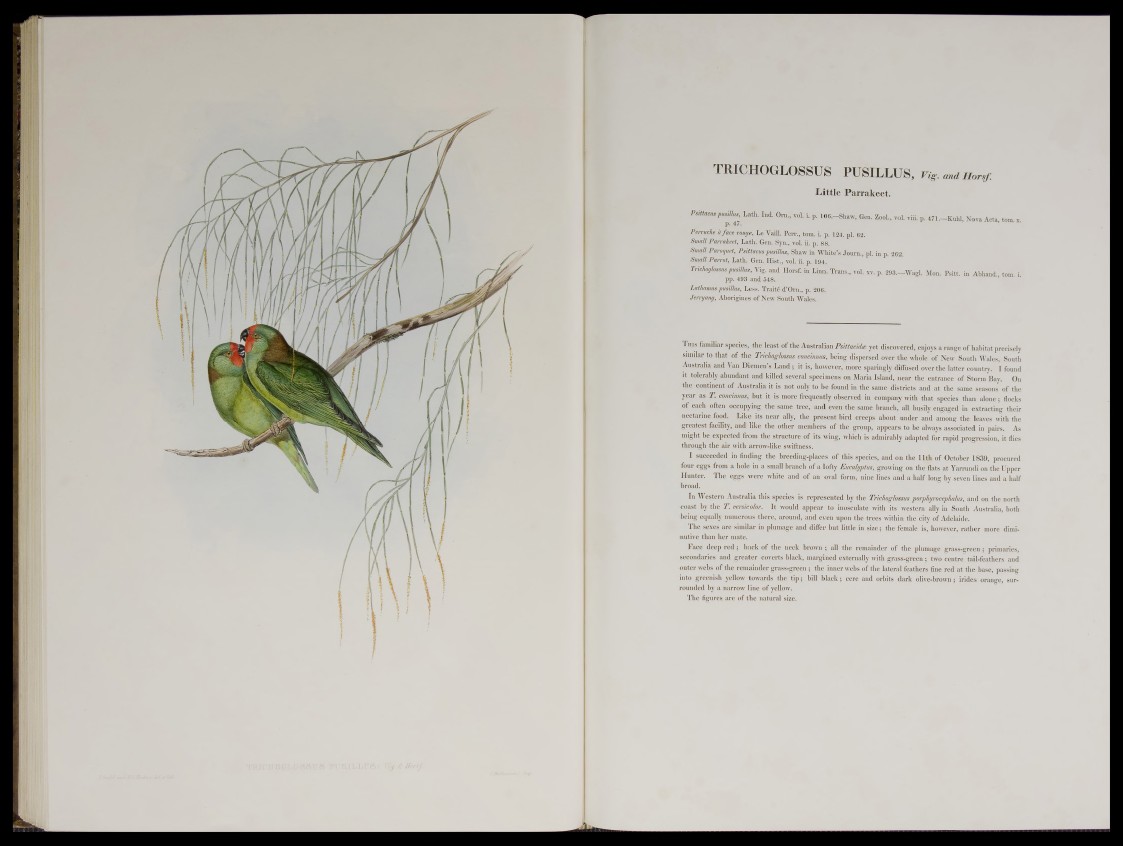
TRICHOGILteüS PUSIJjLUS, Fig-, and Horsf.
Little Parrakeet.
Prnmm Arfa | § S I
tgm; ï. p, 124. J f e g .
“w ' l l ’j i t ,* ! J ujiKtj j j 'jv !^«1* n*p —, j i ’ '
s9^ S ‘m < ^ ^ ^ ^ m s p m a m > r , d*<».
% /.« /'M-f ', 1 ,uji (hg^ H "'
/ ’«■’ W ^ U f t ï f e u i H Q V ^ J S ^ T u d . Mon. Psrtt in Abhand., tom L
pp. 493 and .^t'ljSKr
A«iA«gnifp»<ii'u.i | •” I r uiiaCflif fM W cW
Jerrvem. Aborigines BfeTfeyS n ^ ^ m ,w~. ;
J n u l.imih.ir ,p i' lex. dn lej-.T cit tffiAti-trili,m l ’stiinnln jiu irs-ów ji,dV»|oj-. a rin ti- uf biduur pretholy
Tliofyghssus concinrus, bring dispersed pyjaf tjjewffoJe oBNelf-South Wales,.South.
Australia w d j [ ^ ||j |g j§ ! i ,\4l irul n is, Im i u r , more spirin^lj dijJuM.d o in ilu latter country. I tonnd
it t ^ i l l l l ^ l g o ^ ^ a ^ K l ^ ^ v e j r a l j p ^ m i j ^ g ^ ^ ^ l , ^ ^ p a r the entrance of Storm Bay. On
the c9ntin,®t..o£ Australia i t - ^ - ^ o n l y to be found ip the gape districts «mi a t \ h e same seasons of the
i k f § P concmms, hütgi&jgMjnè frequently observed ini ^ a § ^ 'w ith species thap alonp; flocks
«f em k ' 9ÖSQ occupying the same-tree A n d eveu the sgn^ branch affirasily engaged! in extracting their
nectarine fgQjk "'■J'jhe its neqr all||i l^gr present creeps.' aboufi'under' and among th e leaves with the
greatest facility’ a n t S l ik ^ ^ other members of th e he' always associated in pairs. As
^ ® i^ t‘ ^% e c te < i f a » - th« its is a^lïrably adapted for rapid: progression, it flies
through the air mth; ^rrow-lilce swiftness.
I succeeded in finding the breeding-places, oj^bis sperijsjand o p ^ B lU h o f o S f r 1830, procured
four eggs from a bole in a small branch of a fojfcy Eucalyptus, ‘growing on, the flats at Yarrundi on the Upper
Qunter, | £ | eggs were w b f a ^M p f i itf- oval f o rm i n g lines andath^ ^ W J-lè' - .m i hr. - .u,d a lialf
broad. -
In Western Australia tbis species is represented fry the TricAoglpssus porphyracephaks, and on the north
-coast by the T. versicolor. I t would appear tp ip p ^ u ja te f ew its western a f c ip ’f&ufh Australia, both
t ó n g equ^ly dumgïOjis.'tbere, around, uneven \mon tb< t i ^ ^ ï S i a J t i ^ ^ y f i 'l 'ld . I tuk
The seres are similar in plumage and differ buC^ t l e m size, ()><; f u n d * tl,‘(munvc r^iaihi r more diuri-
nutive than her mate.
Face deep red-; hack of the neck brown; all tjie remainder of the plumage grass-green; primaries,
secondaries and greater coverts black, margined externally with grass-green ^ two centre tail-feathers and
outer wehs of the reminde r grass-green; the inner webs of the lateral feathers fin c c re ^^ the base, passing
into greenish yellow towards the tip ; hill black; cere and orbits dark olive-brown; irides orange, surrounded
by a narrow line of yellow.
The figures, are o f tjae natural size.